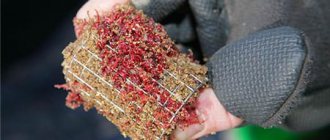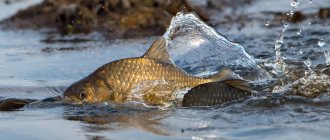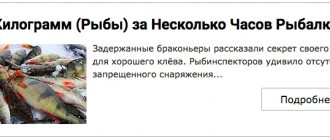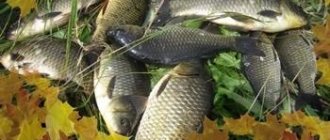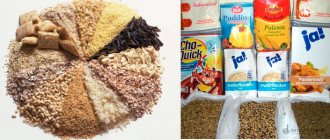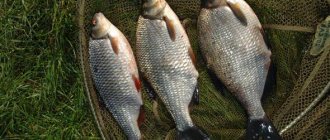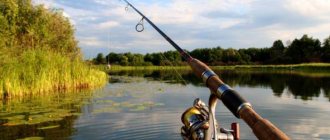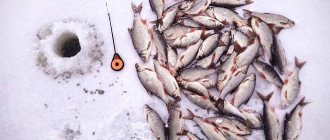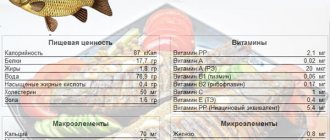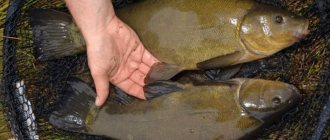Bait for crucian carp has long become a mandatory attribute of fishing, because a fisherman who knows the secrets of crucian carp fishing understands that half of the success depends on this important element of the hunt that attracts trophy specimens. Today, even manufacturers of fishing equipment and equipment offer a wide range of feeds of different compositions, specializing specifically for crucian carp, but bait prepared for individual fishing conditions will undoubtedly be more effective.
Experienced crucian fishermen consistently do this when preparing to go out for crucian carp. And their rightness is confirmed by the catches, in which there is always a place for trophy fish, tempted by the prepared delicacy. Our conversation will be about the recipes and secrets of preparing catchable baits, as a result of which we will help anglers navigate and prepare the ingredients necessary for feeding, determine the final properties of the product for various fishing conditions and describe the taste preferences of fish in different seasons of the year.
Buy or make your own bait
Bait for crucian carp can be simply purchased at any fishing store and its purchase will not require serious investments, and with certain coincidences the angler will be able to get excellent results at the end of fishing. But most likely this will be a pleasant accident, because the capricious crucian carp on each reservoir has its own preferences in choosing flavors and in most cases they do not coincide with the taste of store-bought food.
The food sold in stores is a good basis for preparing the final bait, which requires minor adjustments to the smell and taste, which is achieved by adding the attractant, animal component and diluent necessary for the native of the fished reservoir. Of course, ideally, consult with fishermen who know the reservoir and find out the desired smell of the attractant, but in practice, most often you have to prepare only the base of the mixture at home and experiment with smells directly while fishing, taking with you an arsenal of attractants in the form of essences, ranging from garlic smell to cinnamon.
What to feed crucian carp?
The first rule of bait for any fish, including crucian carp, is that everything included in the composition must be crushed into powder. It is this structure that will allow the bait to quickly disperse in the water and eliminate the possibility of subsequent rotting in the reservoir.
Most fishermen know that it is an omnivorous fish. This circumstance allows you to add a wide variety of ingredients to the bait to attract the attention of rather cautious and capricious fish.
So, what is the best way to feed crucian carp? Basically, several components are used in food for crucian carp, as well as other types of carp fish.
The basis of any bait for crucian carp is the so-called “skeleton”, it can consist of:
- from oatmeal,
- from various types of crackers,
- waste from oil processing,
- from cake,
- bran
A food supply consisting of all kinds of insects is added to the base In action are:
- bite activator,
- bloodworms are a favorite delicacy of many fish,
- maggots are a classic of successful fishing,
- crucian carp goes well on a worm,
- larvae are also recognized by many fishermen as the best bait for crucian carp.
Then comes the turn of the secret ingredients - attractants and flavors.
Attractants
Attractants are special substances that arouse the interest of fish and encourage them to come as close as possible to the fishing spot. It is worth considering that
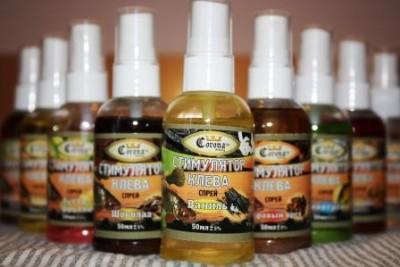
As such a stimulant, various extracts of hormone-rich substances from plants and organic matter are used. Naturally, it is quite difficult to produce a hood at home, so factory products are used. Manufacturers produce attractants in the form of a special solution, the dosage of which is strictly measured and does not exceed the required concentration.
For bait, it is worth recommending products whose “Worm Flavor” additive goes well with corn and maggots.
Flavors
Flavors also attract the attention of fish, but in the area of taste preferences. Essentially, these are seasonings and spices from fish food.
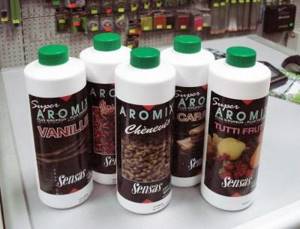
Flavors can be purchased in the form of a balanced mixture of components or a special aerosol with the scent of vanilla, cinnamon or anise, or you can make it yourself by frying and grinding sunflower seeds, hemp seeds, cocoa, chocolate, sugar and much more in a meat grinder, as indicated by the fisherman’s intuition. The main thing in such creativity is not to overdo it with the dosage and start with a minimum amount of additives.
The resulting mixture of food and aromatic additives must be diluted. To do this, use clay or peat , since they break down into small particles and are quickly washed away in the water, carrying along with them the tantalizing smell of bait and a light turbidity that attracts fish.
When preparing bait, it is worth remembering the main rule - it should not be tastier or more attractive than the bait itself.
Preparing ingredients for bait

To prepare mixtures, it is better to prepare in advance by purchasing a certain supply of the most common ingredients for bait. First of all, you need to have an assortment of products for preparing porridge or the base of any food. Porridges are prepared from pearl barley, millet, semolina and rolled oats. A couple of kilograms of these cereals is enough for variety and choice of the preferred base option. You can also stock up on fish feed, which is the classic basis of any bait mixture.
Next in the series of preparations there should be additives. Additives are breadcrumbs used in cooking for baking, milk powder, canned sweet corn and peas, sunflower cake or makha sold in layers, dried hemp, flax and wheat grains, as well as peas. Recently, opportunities have emerged for the procurement of animal ingredients and, in particular, canned maggots, which are widely available for sale, a couple of jars of which can always be kept in reserve.
Important! It is more convenient to store attractants in the form of concentrated flavor essences, which are widely used in cooking and are widely sold.
The most popular bait recipes for crucian carp contain garlic, vanilla, cinnamon, chicory and dill. Of the liquid components of odors, natural honey and molasses can be stored without consequences. Having such an arsenal, an angler can, without much difficulty, prepare the most effective feeding mixture for any conditions in a couple of hours.
The simplest bait recipes
First option
Take three kilograms of wheat, half a kilogram of breadcrumbs and crushed sunflower seeds, one hundred fifty - milk powder, one hundred grams of steamed hemp seeds, twenty - vanilla, fifteen - anise oil, ten - caramel.
Second option
involves mixing ingredients consisting of one kilogram of breadcrumbs, three hundred grams of fried crushed seeds, four hundred grams of bran and wheat porridge.
Also, for one kilogram of breadcrumbs and one and a half kilograms of boiled crumbled wheat, it is recommended to take three hundred grams of chopped fried seeds and two hundred and fifty grams of oatmeal porridge.
Or, to one kilogram of breading, you can add half a kilogram of crushed roasted seeds and wheat bran.
All this should be seasoned with ten to twenty grams of flavorings: grated garlic, vanilla, anise or honey.
Rules for preparing feeding for crucian carp
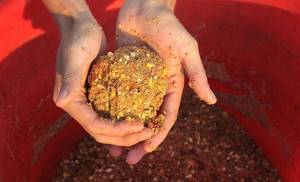
Preparing bait for crucian carp has certain rules, by adhering to which the fisherman increases the effectiveness of the mixture, which undoubtedly leads to an increase in the quantitative and qualitative composition of the catch. At home, as mentioned above, fishermen prepare the base of the mixture with additives without adding an attractant or moisturizing.
These operations are carried out on a reservoir, bringing complementary foods to readiness in small portions and only after making sure that they are working, prepare a large volume for use. Feeding when fishing with a fishing rod based on consistency and density, they prepare mixtures that, when compressed into a ball, can be delivered directly to the bottom of the reservoir, where it will crumble after impact from falling to the ground. Feeder fishing requires less density and such mixed fish should easily come out of the feeder when they reach the bottom. When using fillers, they must be sifted through a sieve, thereby achieving softness, the so-called fluffiness of the prepared mixed mixture in the fishing community. Attractants are diluted in the water of the fished reservoir and only then added to the prepared feed.
Important! When fishing with bait of animal origin, they must be included in complementary food.
The components of animal bait significantly increase the catch.
Rules for feeding
In this section we will talk about the process of feeding crucian carp itself, as well as about baiting (cyclical feeding over several days in order to accustom the fish to a specific feeding place).
After all the necessary bait ingredients have been mixed and the attractant has been added to the bait bucket, we need to feed the selected area with the so-called feeding table.
Tip #1. How to choose a place for feeding? It is advisable that the place has flow. This will allow the bait to wash out throughout the pond and attract crucian carp from long distances. Remember, even in a pond there is a current, it’s just not very strong, but it is best noticeable in the central part or near the dam. This is where you should try your luck. Tip #2. Choose a place with a flat bottom. You can determine it with a marker float, a regular float rod, or by dragging a coarse sinker with a feeder, reading the signal when the weight touches the bottom.
A feeding table is an area at the bottom of a reservoir into which bait is delivered precisely so that the crucian carp will come to that particular place.
Feeding for float fishing
When fishing with a float, the bait is thrown with balls specially crumpled in the hands.
The size of the balls must be chosen depending on the strength of the current and the depth of the fishing spot. The deeper the place and the stronger the current, the larger the balls need to be made so that they are guaranteed to reach the bottom. The standard size of a bait ball is the size of a fist. If you are fishing in the shallows, then use balls the size of a walnut or a little larger so as not to frighten the crucian carp with too strong splashes.
The number of balls for starting feeding for each reservoir is individual. The stronger the current and the deeper the place, the more often you need to feed, but you can start with the same value. In general, count on 0.5 kg to start.
In order to keep the fish biting for several hours, it is necessary to throw in 20% of the original amount of bait every 30 minutes.
If the fish does not come to your starting feed within half an hour , I recommend changing the place. Perhaps the bottom topography turned out to be not so flat, the bait has rolled to another place and you cannot feel it. Or perhaps the current flows around the current place and the crucian carp simply does not know about the presence of bait at the bottom.
Feeding with a feeder
Feeder tackle involves casting bait using a feeder trough.
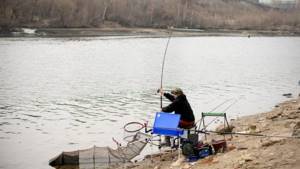
Feeder casting of bait performed by the World Feeder Champion - Alexey Fadeev
Starter feeding should begin with 15-20 feed casts. It's a time-consuming process, but it's worth it and definitely shouldn't be underestimated. In order for the bait to fall in the same place every time - on the first cast, after the feeder lands on one, you need to tighten the fishing line and secure it to the clip of your spinning reel. This will make it possible in the future to throw the feeder with bait at the same distance from the shore.
In order to throw bait correctly not only to the required distance, but also to the correct coordinate, you need to determine the landmark on the opposite bank. It should be static and not change location (a tree is suitable, but a car or a cloud is not). Aim at it every time you cast and you will hit the target exactly.
Important! When fishing on a feeder, the feeder is thrown only from behind. This is done to most accurately hit a landmark on the opposite bank.
Errors in preparing bait
Homemade bait for crucian carp, if the fisherman is inexperienced, is replete with errors in preparation and use, which can reduce the efficiency of feeding, and therefore the final result of fishing. To prevent some common mistakes, we will focus on these factors, reducing their likelihood during the preparation and use of the product.
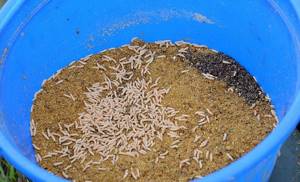
Adding bait of animal origin will increase the chances of success
So, what are the most common mistakes made:
- The density of the mixture is achieved by adding a certain amount of water. A small amount of liquid makes the mixed mixture excessively crumbly and, once in the water, such a composition does not reach the bottom at the feeding point, but is carried away by the current to the side, collecting fish there, outside the supply zone of the main bait. Overmoistening, on the contrary, prevents crumbling after hitting the bottom, which makes the feeding table small in area, and this factor is ignored by large fish and attracts only small things.
- Bait for large crucian carp should also include large fractions in the form of whole grain, worms and maggots. An overabundance of balls will not add success to the fishing, but the size of an individual component of the food will incredibly arouse the interest of trophy fish.
- In cold water, the use of animal baits and their presence in mixtures is more effective. In warm waters, plant components of bait and feed are a priority.
- The presence of an attractant in the feeding mix should be barely noticeable by smell and should not greatly dominate the natural odors of the base, additives and diluents. In cold water, it is better to avoid the use of attractants altogether .
- It is also unacceptable to use several persistent and sharp tastes at the same time; this may even scare away the crucian carp.
- Excessive addition of milk powder can cause the formation of thick and cloudy spots that collect only fines at the fishing point.
Taking into account the above facts, the angler will be able to prepare food that is optimal in its functionality.
Mastyrka recipes
Mastyrka is the name given to baits that are prepared with peas, semolina, flour and potatoes.
A classic recipe where the peas are dried and it is allowed to add sugar or honey, eggs, vegetable oil and food coloring.
Take 700 g of peas of the same color, without damage, and rinse. Soak until morning in cold water. In the morning, bring to a boil (do not take an aluminum pan) and simmer for 1-2 hours. When the peas soften, evaporate the remaining water and mash the peas into a puree. Add semolina and flour (130 g each). Divide into pieces and leave to cool on a towel. Knead the mixture 2-3 times, adding a drop of hemp, linseed or sunflower oil. It is allowed to add a fruity or candy aroma; sometimes crucian carp are attracted by the smell of onion and dill or pepper.
Read: Large crucian carp: secrets of night fishing
Instant mastyrka
Grind the sorted peas in advance and mix with semolina (1:1). Already on the shore, gradually add water and vegetable oil.
Treat for crucian carp
Grind the soaked soft peas in a blender or through a meat grinder. Knead with the addition of semolina and water in which the peas were soaked, flavoring with oil.
Potato Mastyrka
Make mashed potatoes, add pieces of rye bread, corn flour (1 spoon) and unrefined butter. Season with anise drops.
What is garlic for?
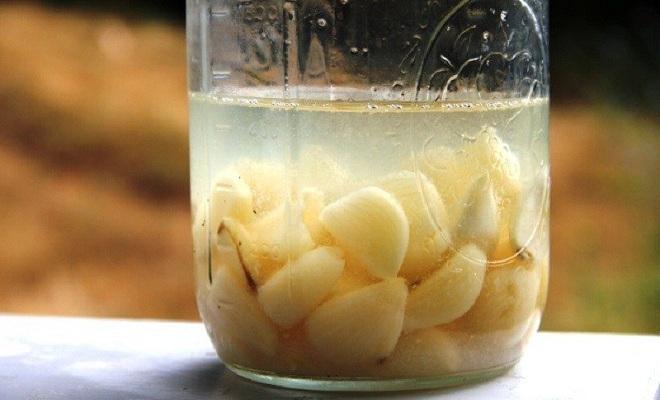
Crucian carp's strong love for the smell of this vegetable is widely known. The reasons for such preferences have not been thoroughly elucidated, but practice confirms the effectiveness of using the smell of garlic in crucian carp fishing.
Important! Feeding crucian carp with the inclusion of the garlic attractant is more effective at the end of summer and in the autumn, when the water begins to gradually cool down.
In addition to feeding, garlic is used to scent baits, both animal and artificial. In particular, foam balls are soaked in freshly squeezed garlic juice and worms, maggots and bloodworms are sprinkled with them before serving them in the fishing area. Garlic juice is also used in the preparation of mash and hominy. For feed, garlic cloves are crushed and mixed into the composition . As already mentioned in the text of the article, it is practical and convenient to use garlic essences, sold as culinary additives in any grocery store. A twenty-gram bag of this product is enough for several fishing trips.
DIY bait recipes for crucian carp
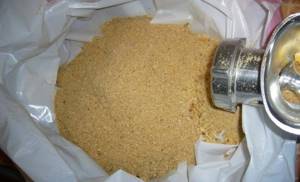
Baits for crucian carp are varied in their composition and proportions of ingredients, and they also differ in preparation methods. Feeding mixtures can be boiled, steamed and simply mixed from ready-made components, subsequently only being moistened. In addition, feed can be saturated with nutrients in different ways, the role of a diluent in which is performed by sifted soil, sand and clay. We will talk in more detail about the most common methods of preparing the product, considering the most popular bases for feed.
Crackers
To make a mix with breadcrumbs you will need:
- Regular or breadcrumbs in a volume of 500 grams;
- Wheat bran - 300 grams;
- Dried or roasted sunflower seeds, crushed in a mixer – 200 grams;
- To sweeten the mixture, use artificial or natural honey, no more than two tablespoons;
- Vanilla – 5 grams.
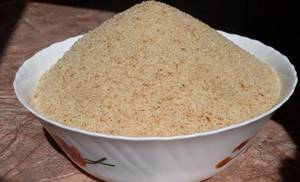
All the above ingredients, not including honey, are thoroughly crushed in a mixer and mixed. After mixing, honey is added and moistened until the required ball consistency is obtained.
Important! An alternative to breadcrumbs can be fish feed or feed for fattening young cattle.
The second type of feed initially contains vanillin in its composition and when preparing this option, the addition of this attractant is not required. All other cooking operations are carried out according to the algorithm described above.
Porridge
Fishermen prepare the lion's share of baits for crucian carp with their own hands based on various types of cereals. Such compositions are characterized by low cost, ease of manufacture and fairly high efficiency in attaching crucian carp. Before use, cereals can be crushed, ground, or used as a whole, and bringing them to the point of readiness can be done either by steaming with boiling water or by simply cooking the porridge in water. Any type of cereals and legumes, including peas and soybeans, is suitable for the base. Porridge can also be prepared from boiled young crushed potatoes, which is also an effective option for bait base in some cases of summer fishing. In continuation of the article, we will present to the reader simple recipes for bait prepared on the basis of cereal grains, which fishermen can independently modify to suit their own conditions and taking into account the experience of fishing in reservoirs where they know the food preferences of crucian carp.
Pearl barley
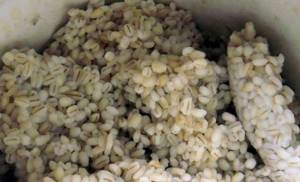
Crucian carp loves barley-based food
It is convenient to prepare bait based on pearl barley because the boiled or steamed grain can be used at the same time as bait, taken directly from the mixed aromatic mixture. Also, with a large fraction of pearl barley, you can mix other types of cereals by preparing multi-feeds. A simple recipe for multi-porridge based on barley is as follows.
- Take 500 grams of pearl barley;
- The second ingredient can be either millet or any other cereal, semolina or rolled oats, which also requires 500 grams;
- Prepared crushed peas - 200 grams.
The cereals are thoroughly mixed and poured with boiling water, leaving to steam in a tightly closed pan for 3-5 hours. After this time, peas are added to the steam and the food is allowed to brew for 1.5 hours.
Barley mono porridge is prepared according to the following recipe.
- Pearl barley -0.5 kg;
- Breadcrumbs – 0.5 kg;
- Natural honey – 1 tablespoon.
Pour pearl barley with boiling water, adding honey to the mixture, and leave in a closed thermos for 3-4 hours. After steaming, add breadcrumbs to the mixture, vigorously stirring the mixture. You can include flaxseed or hemp seed in the finished mix, which gives the complementary foods a special aroma.
Semolina
The composition of semolina-based bait may be different, and we will provide two options. The first option is in the video, and the second is in text.
The composition of semolina for crucian carp is prepared using the technology presented below.
- Semolina porridge prepared in water from 200 grams of raw cereal;
- Regular breadcrumbs in a volume of 200 grams;
- Coarse wheat flour – 200 grams;
- Sunflower flour – 100 grams;
- Flavored cookies - 100 grams;
- Cinnamon – 5 grams.
All of the above ingredients are mixed together using a mixer until the mass is homogeneous in its fraction. Dry complementary food is taken for fishing, and when forming feeding balls, the required amount of water taken from the fished reservoir is added to the composition.
Corn
Mixed mixtures using corn show excellent results of establishment. Let us introduce the reader to one of these simple recipes, but one that actually works for crucian carp.

Corn can attract the attention of large crucian carp
- For cooking you will need boiled corn grain or a grain of canned sweet corn in the volume of three parts of the prepared mash.
- Coarse wheat flour is taken in one part of the total weight of the feed.
The components of the bait are mixed together, pressing the corn kernels to a state in which the resulting mass can easily form into balls. To add flavor to the composition, you can add a couple of drops of anise oil or 2-3 grams of ground dill. For humidification, a small amount of water from the reservoir where fishing is carried out is used.
Recipes for homemade mixtures for summer
Summer complementary food for crucian carp is not difficult to prepare. Below are several recipes for effective and inexpensive summer bait that you can make yourself.
Complementary food with flaxseed
The main requirements for summer bait are aroma, fine grain, contrast with the bottom. The following recipe meets all these requirements. Mix 1 kg of ground crackers and corn grits, 500 g of crushed sunflower seeds, ground biscuits and semolina. Add 20 g of vanilla sugar and cinnamon.
To make bait more effective, you need to use small tricks. When adding 500 g of flaxseed to the mass, the crucian carp's appetite will be stimulated, and metabolic processes will also accelerate. Therefore, even if the crucian carp has had enough and swam away from the fishing point, it will soon be here again and will perfectly take the bait on the hook.

Flaxseeds are perfect as a basis for summer feeding of crucian carp.
In addition, you can add a half-liter can of condensed milk to the bait. Maggots and chopped worms will also not interfere with the fish dish. Animal elements effectively attract crucian carp and increase the chances of an excellent bite.
Usually about 4 kg of ready-made bait is enough to catch fish. It must be placed in a plastic bag, and upon arrival for fishing, add water from the reservoir. Water must be added in 2 additions, with a break of half an hour. It is needed so that the finished delicacy can easily be molded into balls, which can be the size of a small orange. The balls should hold their shape when they hit the surface of the water, and then gradually dissolve at the bottom. One third of the bait should be thrown immediately to the intended fishing site, the rest of the bait should be thrown throughout the fishing.
Pea groundbait
To prepare this complementary food, you need to boil 1 kg of peas. Add to it 1 cup of crushed crackers and flour, 4 pcs. crushed shortbread cookies, 1 tablespoon cocoa powder. The finished mixture must be packaged in plastic bags. Directly at the reservoir, add water to the complementary food (directly from the same river), allow it to swell, and then form balls.
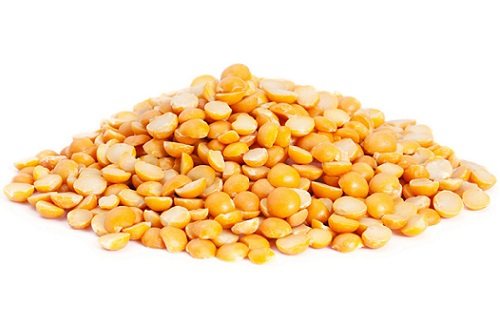
Peas can be used as effective bait in different seasons
Hercules bait
Mix 1 kg of rolled oats, ground crackers, and molehill soil. From this mixture form balls for throwing into the water. This complementary food needs to be moistened when forming balls. In this case, when casting, the ball will more likely fall to the bottom. And after reaching it, it will fall apart without forming much dust.
The humidity and consistency of the balls should be such that they do not crumble before reaching the bottom and do not fall under a layer of silt.
Cereal mixture
To prepare the following recipe for effective summer complementary feeding, you need to mix 1 kg of crushed wheat and barley, 500 g of corn grits, 200 g of semolina, 200 g of cake. The finished dry composition can be distributed several times. On the pond, it will be necessary to bring the bait to the desired condition. To do this, moisten it with water and leave for 20 minutes. As an aromatic additive, you need to add 20 drops of Corvalol. Then form balls from the resulting mixture to throw into the pond.
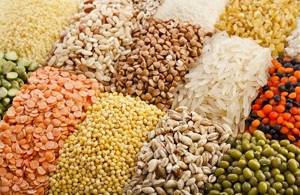
A unique complementary food is a mixture of various cereals
Groundbait with yogurt
Another excellent recipe is a mixture of 100 ml of yoghurt, 1 kg of crushed breadcrumbs and molehill soil. Fish are attracted to fermented milk products and stimulate their appetite. And the presence of soil from molehills does not allow her to eat to her fill. Balls are formed from this mixture and thrown to the fishing spot.
Feeder bait No. 1
Fishing stores offer a wide range of summer baits for feeder fishing. However, not all of them are highly effective. Therefore, it is better to prepare an effective composition with your own hands.
To prepare complementary food for the feeder, you need to mix: 1 kg of crushed crackers, 200 g of ground rolled oats, 300 g of cake, 200 g of semolina, 200 g of corn flour, 400 g of bran. The additive to this bait is selected for a specific body of water. You can use anise, ginger, rhizomes of aquatic plants, coffee, honey or garlic.
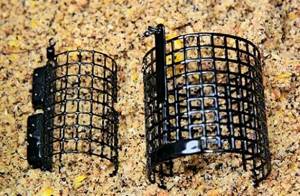
When preparing feeder bait, remember that it is different from regular bait.
Features of some types of porridge for catching crucian carp
Bait for catching crucian carp may have certain features in its preparation, which depend on the place of fishing, and in particular the nuances of preparation are influenced by the depth of the reservoir and the current. To fish deep-sea areas and fish on currents, fishermen prepare porridge according to the Salapin recipe. If fishing is done with feeder gear using spring feeders, then special requirements are imposed on the feed associated with the low viscosity of the prepared composition. In the nuances of preparing products for the specifics of fishing, we will present to the reader recipes for porridges according to the Salapin method of cooking and a recipe for preparing purely feeder complementary foods, carried out on a reservoir through a feed using a spring feeder.
Salapin porridge for fishing

The Salapinsky recipe for porridge for crucian carp includes the following list of components:
- Pearl barley porridge, boiled in water - one part;
- Whole millet – two parts;
- Corn grits, instead of which you can use a barley analogue - four parts;
- The mixture will require nine parts water;
- We achieve a pleasant aroma of porridge by adding vanilla in a volume of 5 grams.
The pearl barley filled with water is cooked over medium heat. Five minutes before the pearl barley is completely ready, add millet and cereal to the porridge. After boiling the mixture for another ten minutes, add vanilla. We determine the readiness of the product by bursting and starting to boil the grains of the cereal. Once ready, the resulting broth is stirred without straining and the product is allowed to brew under a closed pan lid for 2-3 hours.
Porridge for catching crucian carp with a spring
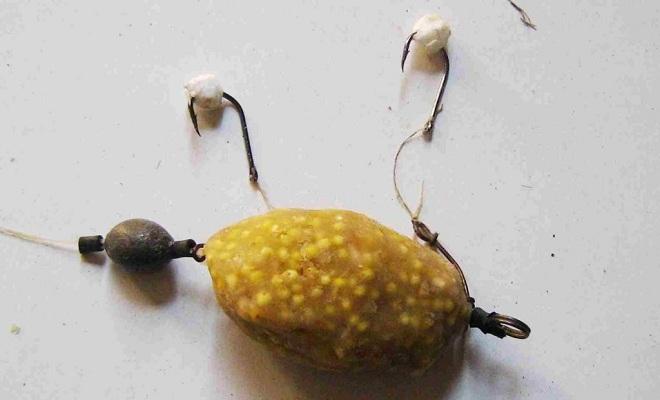
The peculiarities of feeder fishing lie in the preparation of complementary food, which, when undermined or hooked, should easily release the feeder. Such a specific product with low viscosity parameters and fractions of different sizes includes the following list of ingredients in the bait:
- Pearl barley porridge in the amount of 200 grams;
- Fish feed in a volume of 300 grams;
- Regular or breadcrumbs - 200 grams;
- Millet groats – 200 grams;
- Crushed peas or coarse corn flour - 200 grams;
- Store-bought small-fraction crucian carp groundbait with scent -200 grams;
- Sunflower seed - 200 grams.
The cereals are cooked separately until tender. After cooking, they are drained and allowed to cool. After complete cooling, mix the boiled porridge with all the other ingredients. Humidification is carried out at the fishing site.
Store-bought bait versus homemade mixture
When choosing bait for catching crucian carp, the angler must take into account the characteristics of the reservoir. It is advisable to consult with a person who has experience in catching crucian carp in a given pond or lake.
Crucian carp is the most common fish in Russian ponds, but at the same time one of the most finicky
When preparing for fishing in an unfamiliar body of water, preference should be given to a purchased mixture. Industrially produced bait for catching crucian carp has a number of advantages.
- When developing the recipe, manufacturers take into account the recommendations of ichthyologists and famous fishermen. Therefore, for the average crucian carp, the industrial composition turns out to be the most balanced and attractive.
- Store-bought bait is perfectly moisturized, which allows you to achieve optimal consistency. Feeding with such a mixture allows you to create an attractive spot, both in the horizontal and vertical planes.
- A ready-made commercial mixture significantly saves the fisherman’s precious time , reducing the time spent at the stove to a minimum.
But despite all the versatility of store-bought bait, it cannot take into account the nutritional characteristics of fish in a particular body of water. This is especially typical for small ponds and lakes located near villages and hamlets.
This is where the traditional porridges of local fishermen come to the rescue. For years, crucian carp are accustomed to those agricultural crops that are grown annually in the region. Therefore, in some areas, millet becomes the basis for bait, and in others, corn grits or flour.
How to make bait for crucian carp according to the season
The seasonally different food preferences of crucian carp also make significant changes in the preparation of bait mixtures. Depending on the water temperature, the ingredients themselves and the volumes of the attractant change. In continuation of the article, we will focus on classic seasonal recipes that allow you to mix or cook bait that meets one or another seasonal food preferences of crucian carp.
The best bait for crucian carp in summer
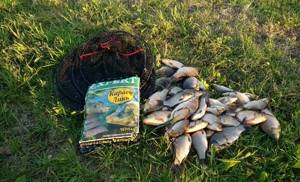
In warm summer water, crucian carp prefer a plant-based diet. Seeds of cereals and other plant crops often end up in reservoirs, and the water areas are replete with all sorts of algae suitable for fish, which is undoubtedly what crucian carp take advantage of. During the summer season, the following bait composition works effectively:
- Take dried peas - 1 kg;
- 200 grams of ground crackers;
- 200 grams of sunflower or corn flour;
- 100 grams of sweet vanilla cookies.
Cook the peas until they are fully cooked and the product becomes soft and loose. Grind crackers, flour and cookies in a mixer until a fine fraction is obtained. Add a ground mix of the above components to the strained peas. Add vegetable oil to the resulting product after mixing; sunflower, flaxseed or olive oil are suitable.
What to feed in spring
In the spring, when the water begins to warm up, bait with additives of animal origin is used, which is much better at attracting crucian carp that have become thin over the winter. We bring to the reader’s attention one of these feeding compositions for spring fishing.
- We form complementary foods based on millet, of which 1 kg is required.
- Season 1/10 of the mix with chopped dung worms and small feed bloodworms, slightly squeezing the larvae.
- The third component is flour, wheat, rye or corn, the main thing is coarse grinding. You will need 200 grams of flour.
Initially, boil the millet in water until completely cooked, which can be seen from the boiling of the grain. Strain the resulting broth and let it cool completely. After cooling, add flour and animal ingredients, chopped worms or bloodworms to the porridge. When fishing in the spring in water that begins to warm up intensively, the quantitative composition of the animal component is gradually reduced, replacing it with plant additives.
What to feed in the fall
In the fall, the appetite of crucian carp improves, and it becomes less picky and capricious than in the summer when choosing baits. Now he is mostly interested only in protein-rich animal food, which should be taken into account when making bait. Let us dwell on one of the practice-tested recipes for autumn crucian carp bait.
- We take regular or breadcrumbs weighing 500 grams as a basis.
- You will also need 200 grams of roasted sunflower seeds.
- Ten percent of the resulting mix should be the animal component, which can be added either individually or mixed in various variations. The animal additive is a worm, maggot or bloodworm.
- Attractant – vanillin, 3 grams.
The crushed seeds and ground crackers are thoroughly mixed using a kitchen mixer. Add the animal additive and flavoring to the resulting mixture, again thoroughly stirring the composition. Humidification is carried out already on the shore of the reservoir, after compression, small-sized bait balls are formed from the plastic mass.
Consistency and composition by season
Before you worry about what to feed crucian carp, you need to think about how it will be used. The time of year and type of gear determines the basic composition, consistency, and aromatics. Plus the conditions of the reservoirs - at a minimum, the strength of the current, as well as the color of the bottom, the transparency of the water. The tastes of crucian carp differ in different bodies of water. Of course, you need to experiment with the aromatics and components of the bait for crucian carp. However, for success in fishing, the bait must initially be done correctly.
Spring
In cold water, crucian carp cannot actively feed, since their metabolism is slowed down due to the low water temperature. But you need to eat, except when he sleeps, buried in the mud, and exists at the expense of accumulated reserves. Crucian carp feed little and selectively, preferring easily digestible protein food - mainly bloodworms.
Therefore, groundbait as in summer, in large portions with grain, is not suitable. Sometimes it is better to do without feeding at all, relying on active search. However, in some reservoirs, especially where there is a lot of crucian carp, bait works even in winter, and not just small powder, but with pearl barley or millet.
It is impossible to say unequivocally what kind of bait crucian carp and carp (carp) like in the spring - it all depends on local conditions and the speed of the onset of spring. The principle is the same - in early spring, in cold water, we use a little groundbait, small bait, preferably with bloodworms, without grain, with cold aromatics. It can be anise, dill, fennel or no flavoring at all. As the weather gets warmer, we introduce more food elements, and porridges begin to work.
In May - already like in summer, the bulk is needed only to hold the mass together, and the main component that attracts crucian carp is something larger that can be eaten, and not just smelled. These are chopped worms, corn, pearl barley or millet.
Read more about the correct bait for crucian carp in the spring
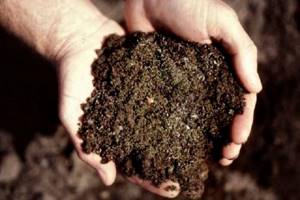
Summer
It is imperative that bait for catching crucian carp in summer must contain a large feed fraction. It is necessary for the crucian carp to stand on the spot and begin to feed. If there is only fine dust and turbidity, roach or small silver bream will most likely do. This also applies to donks - fishermen like to use plasticine so that they don’t wash out longer. However, if we want large crucian carp, and a lot of it, it is better to rely on porridge.
There are a lot of recipes on YouTube on how to cook bait for crucian carp from millet, pearl barley or peas. What is more important here is not a specific recipe, but the selection of a composition for a specific body of water. In some places it goes better for peas, in other places for corn. And the mass for kneading can be breadcrumbs, cake, homemade mixture or store-bought bait. We are experimenting with aromatics - in warm water we are looking for what the crucian carp reacts to better. Multi-colored particles - yellow, red, white, homemade crumbs or pastoncino - will also be useful.
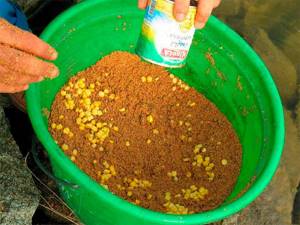
Autumn
As the water gets colder, the countdown begins. The closer we get to winter, the less rich and sweet aromas we use to prepare top dressing. We pour in less porridge - more finely dispersed components. And the total amount of bait thrown into the water needs to be reduced until we reach a couple of balls at the point, with bloodworms, like in early spring or winter.
It’s not enough to feed crucian carp in cold water – you still need to find a silver one. It can stand in one place, and no matter how much porridge you throw into the water, it won’t fit. But when the fish is found, it may be useful to throw a couple of balls at the point to hold the school. The principle works again - we feed less, we look for more. Article about baiting for crucian carp in the fall
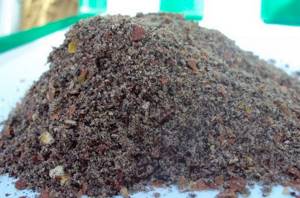
Winter bait for crucian carp
In winter, if the crucian carp does not sleep, we feed little, preferably live bloodworms. But if it is not there, we use special winter mixtures. In some places he also uses regular bait - millet mixed with cake, breadcrumbs or a store-bought mixture. However, for this you need to know that in this reservoir it really attracts crucian carp. In ponds, bait often only scares away winter crucian carp. Article about winter bait for crucian carp on the subglacier ru.

Review of popular store baits
Manufacturers are trying to produce a product that satisfies the requirements of the fisherman and effectively lures fish to the hunting zone. Among the mass of such products, we can offer for consideration some bait compositions that, being universal, can interest crucian carp or can be modified by the fisherman to suit the necessary conditions. The best bait for crucian carp will be presented to the reader in five versions, using which you can confidently count on bites.

Traper Sekret works well during periods of warm water. The product has a persistent odor and a fine fraction that can perfectly cover the feeding table even after serving one massive ball.
The Russian Fish.ka has also gained trust among crucian carp fishing enthusiasts. The varied fraction of mixed mixtures, combined with the ability to choose different types of flavoring, increases the chances of successful fishing.
Fans of feeder fishing should pay attention to the Marcel Van Den Eynde Feeder . The low viscosity of the product and the subtle degree of aromatization do not leave without catches even during periods of relative lack of bite.
The domestic product from FishBait pleases with its affordable price and opportunities for good spring fishing. The neutral bait of this brand provides the prerequisites for using your own attractant that is necessary for the fishing conditions.
Gf Crucian mixture is distinguished by the possibility of choosing bait by color and fraction size. Some fishermen consider the disadvantage that the flavor must be additionally added to the composition from a capsule separately included in the package. But we would attribute this to the advantages of the manufacturer in the implementation of feeding for crucian carp, because the odor-neutral composition can be saturated with the attractant that the fish currently likes.
How to properly feed crucian carp
A well-chosen composition of bait is only part of the key to the success of crucian carp fishing. Feeding technology also plays an important role. The technology has certain rules and nuances that you need to know and should adhere to during the fishing process.
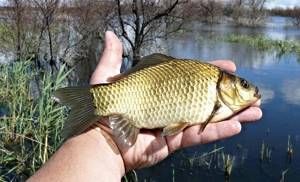
- The important point is not to overfeed the fish. Once full, the crucian carp will stop pecking. The first rule is that there should not be enough complementary food, rather than plenty of it.
- Proper moistening of the bait, in which the balls break on the bottom and not on the surface of the water, increases catches by concentrating the feeding table within certain boundaries.
- Form the feeding table by throwing balls a meter before supplying the bait. When the balls fall to the bottom, even in still water, they shift in the direction of the throw. During the current, for these purposes, compare the depth and strength of the stream.
- Feed in small portions every 1.5 - 2 hours, including different fractions of components in the balls. Millet bait will require the addition of large pinches of crumpled bread. Barley-based mixtures will work with small flax seeds.
- In non-overgrown reservoirs, bait with a high-calorie component works more effectively. These additives include all animal ingredients, maggots and bloodworms, sunflower cake, sweet cookies, honey and regular halva.
